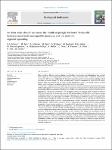At what scale should we assess the health of pelagic habitats? Trade-offs between small-scale manageable pressures and the need for regional upscaling
| dc.contributor.author | Graves, CA | |
| dc.contributor.author | Best, M | |
| dc.contributor.author | Atkinson, A | |
| dc.contributor.author | Bear, B | |
| dc.contributor.author | Bresnan, E | |
| dc.contributor.author | Holland, Matthew | |
| dc.contributor.author | Johns, DG | |
| dc.contributor.author | Machairopoulou, M | |
| dc.contributor.author | McQuatters-Gollop, A | |
| dc.contributor.author | Mellor, A | |
| dc.contributor.author | Ostle, C | |
| dc.contributor.author | Paxman, K | |
| dc.contributor.author | Pitois, S | |
| dc.contributor.author | Tett, P | |
| dc.contributor.author | Devlin, M | |
| dc.date.accessioned | 2023-07-17T10:27:59Z | |
| dc.date.available | 2023-07-17T10:27:59Z | |
| dc.date.issued | 2023-10 | |
| dc.identifier.issn | 1872-7034 | |
| dc.identifier.issn | 1872-7034 | |
| dc.identifier.other | 110571 | |
| dc.identifier.uri | https://pearl.plymouth.ac.uk/handle/10026.1/21048 | |
| dc.description.abstract |
Major planktonic lifeforms such as diatoms, dinoflagellates, meroplankton and holoplankton have recently shown significant and alarming changes in abundance - mainly downwards trends - around the northwest European shelf. This has major implications for food web connections and for ecosystem services including seafood provision and carbon storage. We have quantified these changes in abundance for 2006–2019/20 using a Plankton Index (PI) and show that the scale of spatial aggregation is critical to the ability of the PI to detect change, understand causal mechanisms, and provide advice to policymakers. We derived PI statistics in the Celtic and North Seas from data from the Continuous Plankton Recorder survey offshore and England’s Environment Agency inshore using three sets of spatial units: (i) Ecohydrodynamic (EHD) units based on hydro-biogeochemical modelling, (ii) ‘COMP4′ areas based on cluster analysis of satellite data for chlorophyll a and primary productivity, and (iii) English coastal and estuarine Water Framework Directive (WFD) waterbodies. For the largest scale areas, the EHD units (median size 87,000 km2), we find greater change in plankton communities than previously reported, suggesting that these shifts have continued and possibly intensified in recent years. The smaller-scale COMP4 areas (median size 6,700 km2) appear to encompass more spatially coherent changes in plankton community structure than EHD units; at this scale PI values indicate community shifts of greater magnitude. These COMP4 areas provide a reasonable compromise scale for linking offshore plankton communities to large-scale drivers of change such as climate warming. For inshore plankton communities, larger changes are detected at the smaller WFD waterbody scale (median size 11 km2). This scale allows direct links to coastal management measures and is more suitable for linking to land-sourced pressures. Recent integration of the UK’s OSPAR and WFD plankton monitoring data management enables the exploration of changes across spatial scales to develop a holistic understanding of ecosystem health. Regional-sea scale derivation of the PI for coastal waters provides a clear indication that changes are occurring, at least in phytoplankton communities, while localised PI statistics offer an additional layer of information which can be an important tool for linking to localised drivers of change including coastal anthropogenic pressures. Broadscale inshore zooplankton monitoring is needed to evaluate the coastal plankton community holistically; zooplankton communities offshore are also changing but these changes cannot currently be linked to coastal processes. Layering information across spatial scales provides a breadth of system-level understanding beyond what any one typology can provide. | |
| dc.format.extent | 110571-110571 | |
| dc.language | en | |
| dc.publisher | Elsevier | |
| dc.subject | Assessment areas | |
| dc.subject | Ecohydrodynamic Units | |
| dc.subject | Plankton | |
| dc.subject | Functional groups | |
| dc.subject | Plankton Index | |
| dc.subject | Monitoring | |
| dc.title | At what scale should we assess the health of pelagic habitats? Trade-offs between small-scale manageable pressures and the need for regional upscaling | |
| dc.type | journal-article | |
| dc.type | Journal Article | |
| plymouth.author-url | https://www.webofscience.com/api/gateway?GWVersion=2&SrcApp=PARTNER_APP&SrcAuth=LinksAMR&KeyUT=WOS:001045063500001&DestLinkType=FullRecord&DestApp=ALL_WOS&UsrCustomerID=11bb513d99f797142bcfeffcc58ea008 | |
| plymouth.volume | 154 | |
| plymouth.publication-status | Accepted | |
| plymouth.journal | Ecological Indicators | |
| dc.identifier.doi | 10.1016/j.ecolind.2023.110571 | |
| plymouth.organisational-group | |Plymouth | |
| plymouth.organisational-group | |Plymouth|Faculty of Science and Engineering | |
| plymouth.organisational-group | |Plymouth|Faculty of Science and Engineering|School of Biological and Marine Sciences | |
| plymouth.organisational-group | |Plymouth|Users by role | |
| plymouth.organisational-group | |Plymouth|Users by role|Academics | |
| dcterms.dateAccepted | 2023-06-26 | |
| dc.date.updated | 2023-07-17T10:27:58Z | |
| dc.rights.embargodate | 2023-7-18 | |
| dc.identifier.eissn | 1872-7034 | |
| dc.rights.embargoperiod | forever | |
| rioxxterms.versionofrecord | 10.1016/j.ecolind.2023.110571 |


